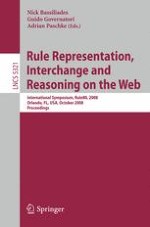The 2008 International Symposium on Rule Interchange and Applications (RuleML th 2008), collocated in Orlando, Florida, with the 11 International Business Rules - rum, was the premier place to meet and to exchange ideas from all fields of rules te- nologies. The aim of RuleML 2008 was both to present new and interesting research results and to show successfully deployed rule-based applications. This annual sym- sium is the flagship event of the Rule Markup and Modeling Initiative (RuleML). The RuleML Initiative (www.ruleml.org) is a non-profit umbrella organization of several technical groups organized by representatives from academia, industry and government working on rule technologies and applications. Its aim is to promote the study, research and application of rules in heterogeneous distributed environments such as the Web. RuleML maintains effective links with other major international societies and acts as intermediary between various ‘specialized’ rule vendors, appli- tions, industrial and academic research groups, as well as standardization efforts from, for example, W3C, OMG, and OASIS.
